Ever since SRAM introduced the first 12-speed mountain bike group in early 2016, I've been riding SRAM Eagle components on my personal mountain bikes. (And I've had more than a few.) There's a good reason for this. SRAM Eagle has established itself as the benchmark for mountain bike drivetrains with wide gear range, chain security, and reliable shifting.
Fortunately, since it launched X01 Eagle and XX1 Eagle, SRAM has trickled the technology down to more affordable parts. I’ve ridden everything from entry-level NX Eagle drivetrains to GX to X01 to the super-blingy XX1. I'm not alone either. Most of my coworkers at The Pro's Closet ride SRAM Eagle drivetrains.
There are multiple SRAM Eagle groups that provide options for riders with different budgets and riding needs. So let's go through the details to help you figure out which parts are right for your next used mountain bike.
[button]Shop SRAM[/button]
The SRAM Eagle group hierarchy: SX, NX, GX, X01, XX1
Let's focus on just two of these groups for today — two that I have spent the most time on — the mid-tier GX group and the top-of-the-line mechanical XX1 group.
 GX Eagle is the workhorse of the Eagle family. This is the most popular SRAM mountain bike drivetrain. It's found on many mid-level and even some high-end bikes. It is also the most common Eagle drivetrain you'll see on the employee rack at TPC.
GX Eagle is the workhorse of the Eagle family. This is the most popular SRAM mountain bike drivetrain. It's found on many mid-level and even some high-end bikes. It is also the most common Eagle drivetrain you'll see on the employee rack at TPC.
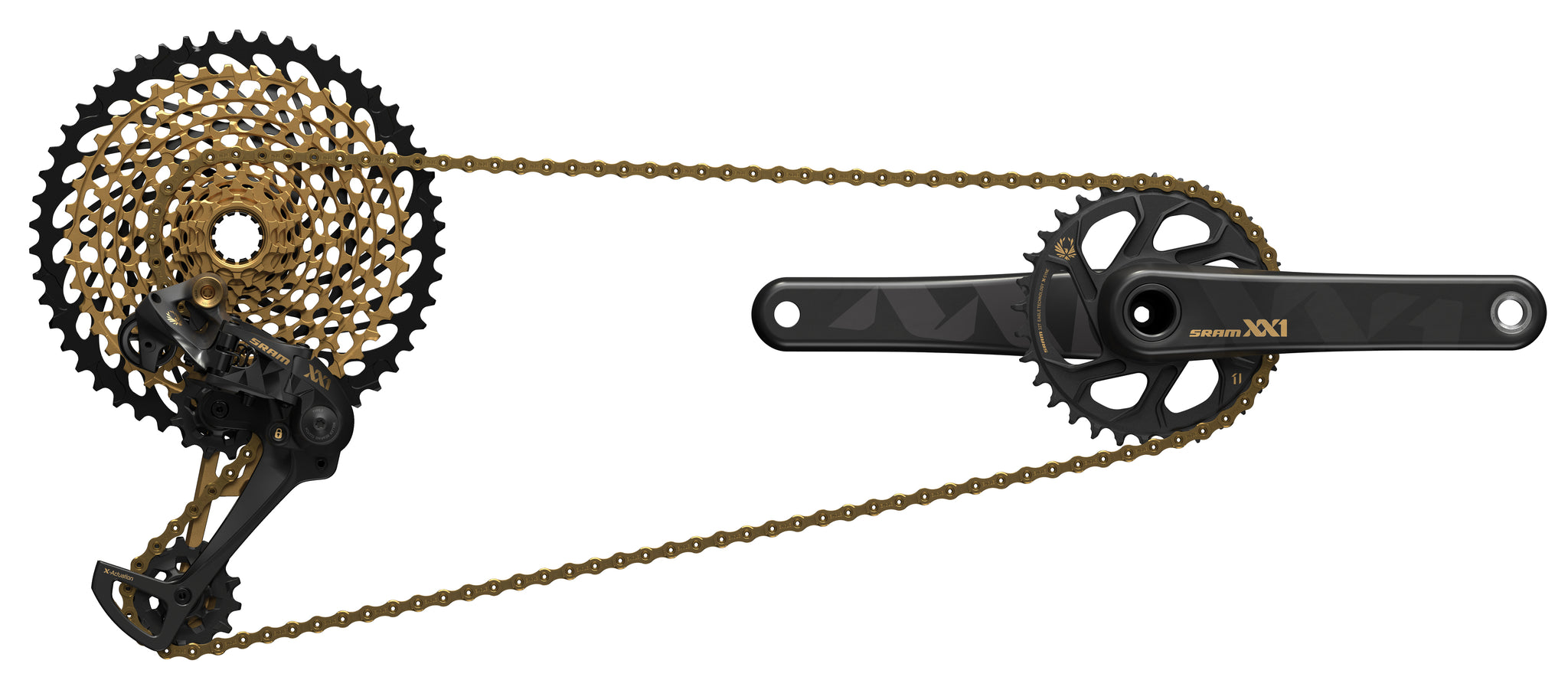 XX1 is the top-of-the-line group. You will see XX1 Eagle used by many top racers and industry insiders. XX1 Eagle AXS is an even higher-end electronic option, but this article only compares the mechanical XX1 with the GX group, apples to apples. Stay tuned for an in-depth review of Eagle AXS in the next month or so.
XX1 is the top-of-the-line group. You will see XX1 Eagle used by many top racers and industry insiders. XX1 Eagle AXS is an even higher-end electronic option, but this article only compares the mechanical XX1 with the GX group, apples to apples. Stay tuned for an in-depth review of Eagle AXS in the next month or so.
If you’re looking to upgrade to an Eagle drivetrain, or you are comparing two bikes with different builds, how do you decide which drivetrain is for you? Do you just need the workhorse? Or do your bikes deserve some bling? Let’s explore the similarities and differences between GX and XX1 to find out.
SRAM GX Eagle vs. XX1 Eagle by the numbers
| GX Eagle | XX1 Eagle | |
| Crankset | Alloy | Carbon fiber |
| Crankset weight | 621g | 433g |
| Cassette weight | 454g | 355g |
| Chain | Solid pins | Hollow pins |
| Derailleur | Steel pulley cage | Carbon pulley cage |
| Shifters | Non-adjustable levers | Adjustable levers |
| Price | $545 | $1,500 |
[button]Shop SRAM[/button]
Similarities
Both GX and XX1 Eagle are 12-speed, 1x drivetrains. There is a single chainring, no front derailleur, and both use 10-50t or 10-52t cassettes that provide a wide gear range. This is enough gearing to handle everything from fast downhills to flat and rolling terrain to steep mountain climbs.
Gearing can be fine-tuned by changing the chainring. Stock chainrings range in size from 30-34t, with 32t being the most common. Cross-country racers might opt for a 34t, while enduro riders in steep terrain on heavy 29er bikes, sometimes prefer 30t chainrings.
Eagle chainrings are direct-mount and utilize the new, more sculpted X-Sync 2 tooth profile which is optimized for SRAM’s 12-speed chain. This improves chain retention, durability, and mud-shedding.
Both the GX and XX1 Eagle cassettes are compatible with SRAM XD Driver freehubs. If your wheel has a traditional Hyperglide freehub, the entry-level SX and NX cassettes are the only options for that Eagle gear range, and they are considerably heavier.
Both GX and XX1 use 28.99mm diameter DUB spindles compatible with the SRAM DUB bottom bracket standard. Older versions have GXP and BB30 spindle options, but these are being phased out in favor of the more universal DUB standard. All cranks are available in 170mm or 175mm lengths.
[newsletter]
Price
Not surprisingly, price is the most noticeable difference between GX and XX1. XX1 Eagle costs nearly three times more GX Eagle. Depending on the vendor, a complete GX Eagle drivetrain retails for around $545 while XX1 will retail for closer to $1500.
This price difference is mainly due to materials and construction. What does the extra money get you, and is it worth it? Let's dig into the details.
Weight
Even if you aren’t a full-on weight weenie, you’re probably aware of bike weight. We weigh every component and bike we sell on our website. On our scales, a complete GX group weighs around 250 grams more than an XX1 — a little more than half a pound. Most of this weight difference largely comes down to the cranks and cassette (more on that in a second). To put that into perspective, a full 20oz water bottle weighs approximately 570 grams or 1.25 pounds.
Does a half-pound of bike weight matter? That's a question you'll have to answer for yourself. I’m especially susceptible to gram-shaving. If my bike is marginally lighter, it makes me feel faster, whether that’s true or not. For more information about the importance of bike weight, check out this article from last year: Does Bike Weight Matter?
Cranks
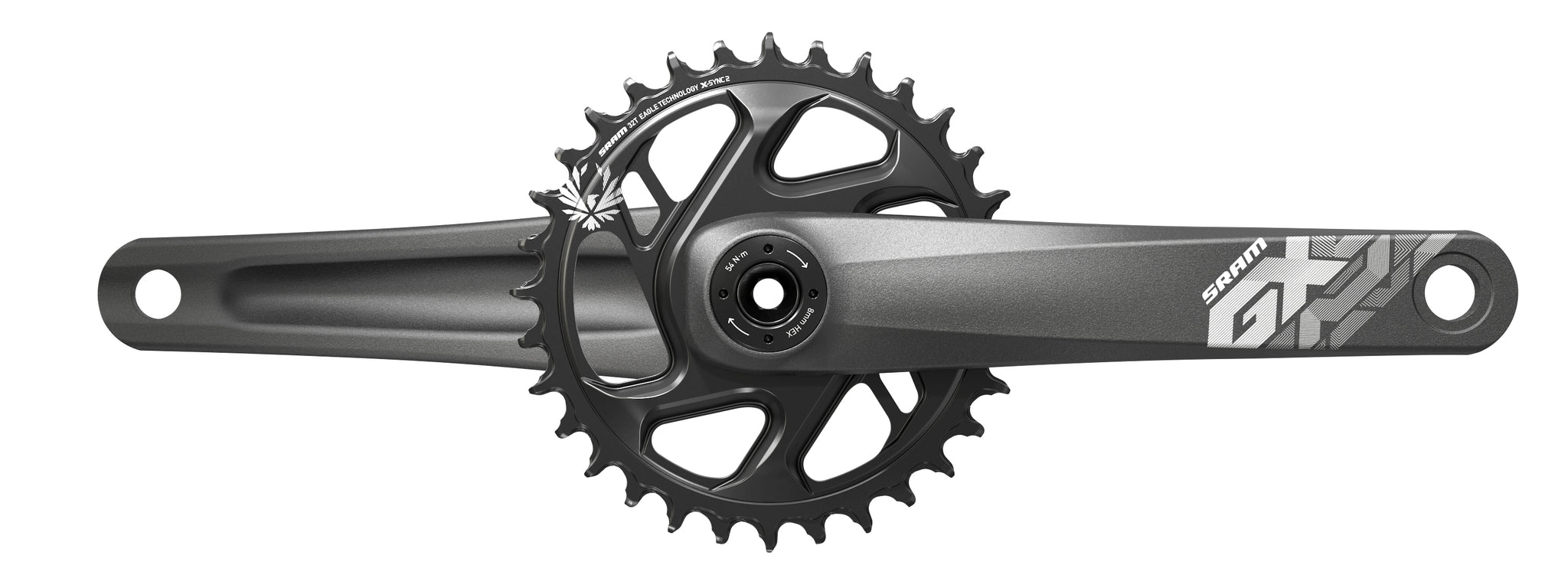 The major difference between GX and XX1 cranks is the material. GX crankarms are made of 7000-series aluminum, which is heavier than carbon but lighter than the 6000-series aluminum used on entry-level SX and NX cranks.
The major difference between GX and XX1 cranks is the material. GX crankarms are made of 7000-series aluminum, which is heavier than carbon but lighter than the 6000-series aluminum used on entry-level SX and NX cranks.
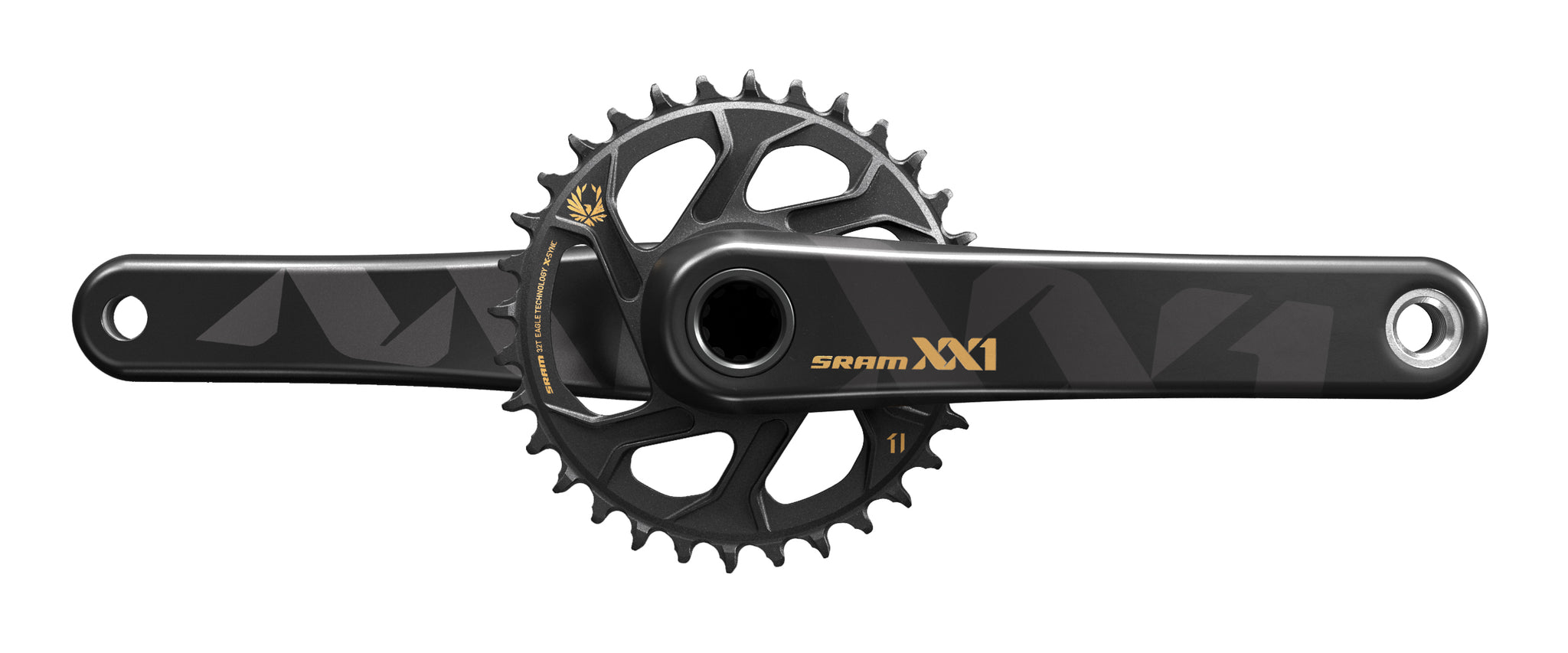 XX1 crank arms are hollow carbon fiber. This reduces the overall weight and improves the stiffness of the crank arms. The XX1 crank spindle also has some additional machining to save weight.
XX1 crank arms are hollow carbon fiber. This reduces the overall weight and improves the stiffness of the crank arms. The XX1 crank spindle also has some additional machining to save weight.
The chainrings included with GX and XX1 cranks use the same X-Sync 2 tooth profile, but the GX chainring is stamped aluminum while the XX1 chainring is machined. This saves a little weight and may improve chainring stiffness.
In total, the XX1 cranks weigh less than GX by about 150 grams. Depending on the spindle configuration, I found they weigh between 480-490 grams with the chainring installed. This makes the XX1 cranks one of the lightest mountain bike cranks on the market, comparable to the carbon RaceFace Next SL crank and titanium Cane Creek eeWings cranks.
Because the XX1 crank arms are carbon fiber, you should run them with the included rubber crank boots to protect them from rock strikes and trail debris.
[button]Shop SRAM[/button]
Cassette
The main difference between the GX and XX1 cassette is the construction.
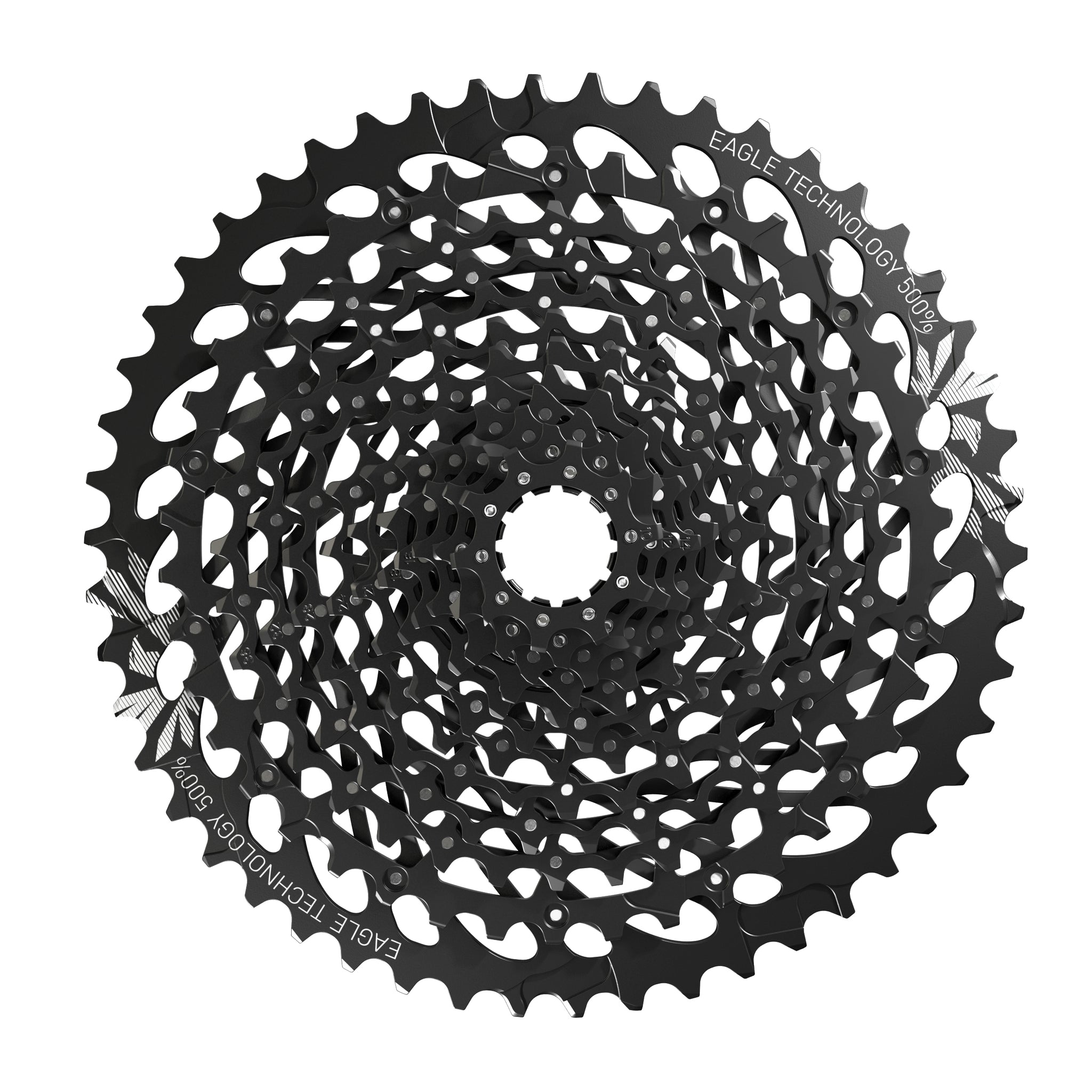 The GX cassette is one piece and it’s made by pinning all the cogs together. The large cog is alloy, and the other cogs are steel.
The GX cassette is one piece and it’s made by pinning all the cogs together. The large cog is alloy, and the other cogs are steel.
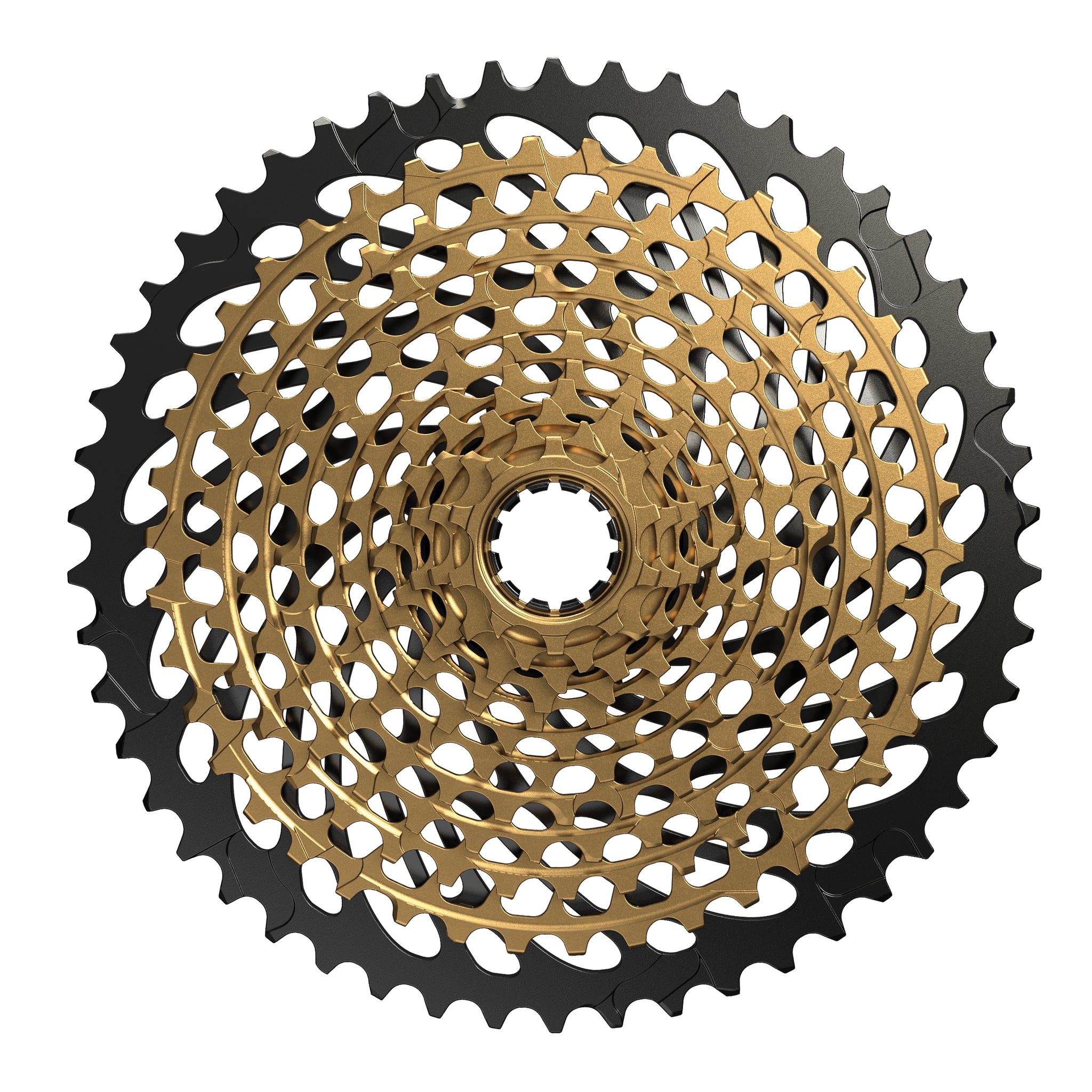 The XX1 cassette also uses an alloy large cog, but the entire steel cog cluster is machined from one piece of steel, creating a hollow dome that’s then attached to the large cog.
The XX1 cassette also uses an alloy large cog, but the entire steel cog cluster is machined from one piece of steel, creating a hollow dome that’s then attached to the large cog.
Because the XX1 cassette is machined and doesn’t use pins, it's significantly lighter and more durable. It also has a flashy gold coating that will further improve corrosion resistance and durability. The machined XX1 cassette saves about 80-90 grams over the GX cassette. It is, to my knowledge, the lightest 12-speed cassette on the market.
Rear derailleur
All Eagle derailleurs essentially function the same way. There are a few differences in construction.
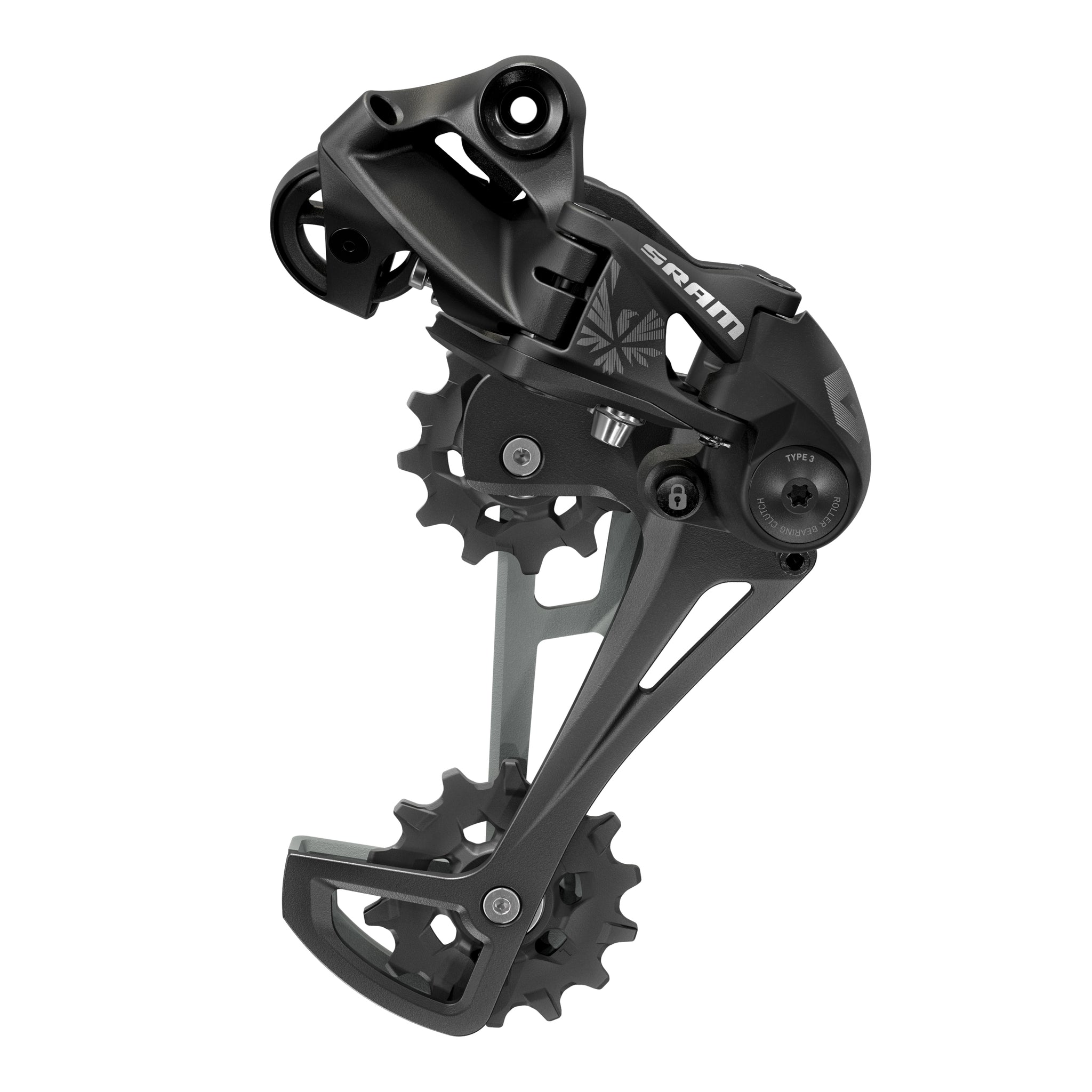 The GX derailleur is built using standard steel hardware. The pulley cage is steel. Overall, it is solid and reliable.
The GX derailleur is built using standard steel hardware. The pulley cage is steel. Overall, it is solid and reliable.
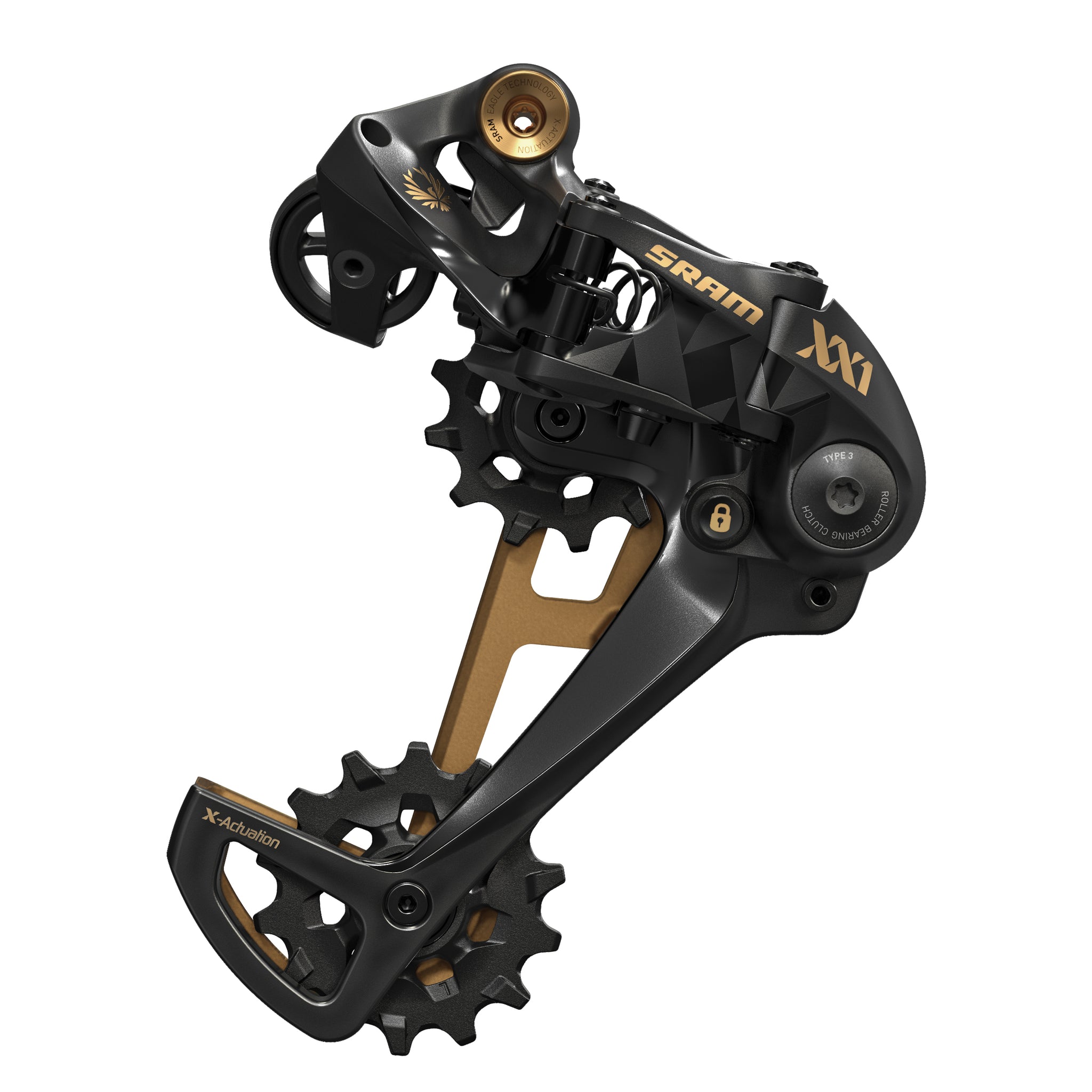 The XX1 rear derailleur is more refined due to a carbon fiber outer pulley cage, alloy inner cage, and titanium bolts that reduce weight by 25-30 grams.
The XX1 rear derailleur is more refined due to a carbon fiber outer pulley cage, alloy inner cage, and titanium bolts that reduce weight by 25-30 grams.
Feel and function between the derailleurs will be very similar. SRAM claims the XX1 derailleur is built to higher tolerances, leading to better shifting and durability under regular use.
Shifter
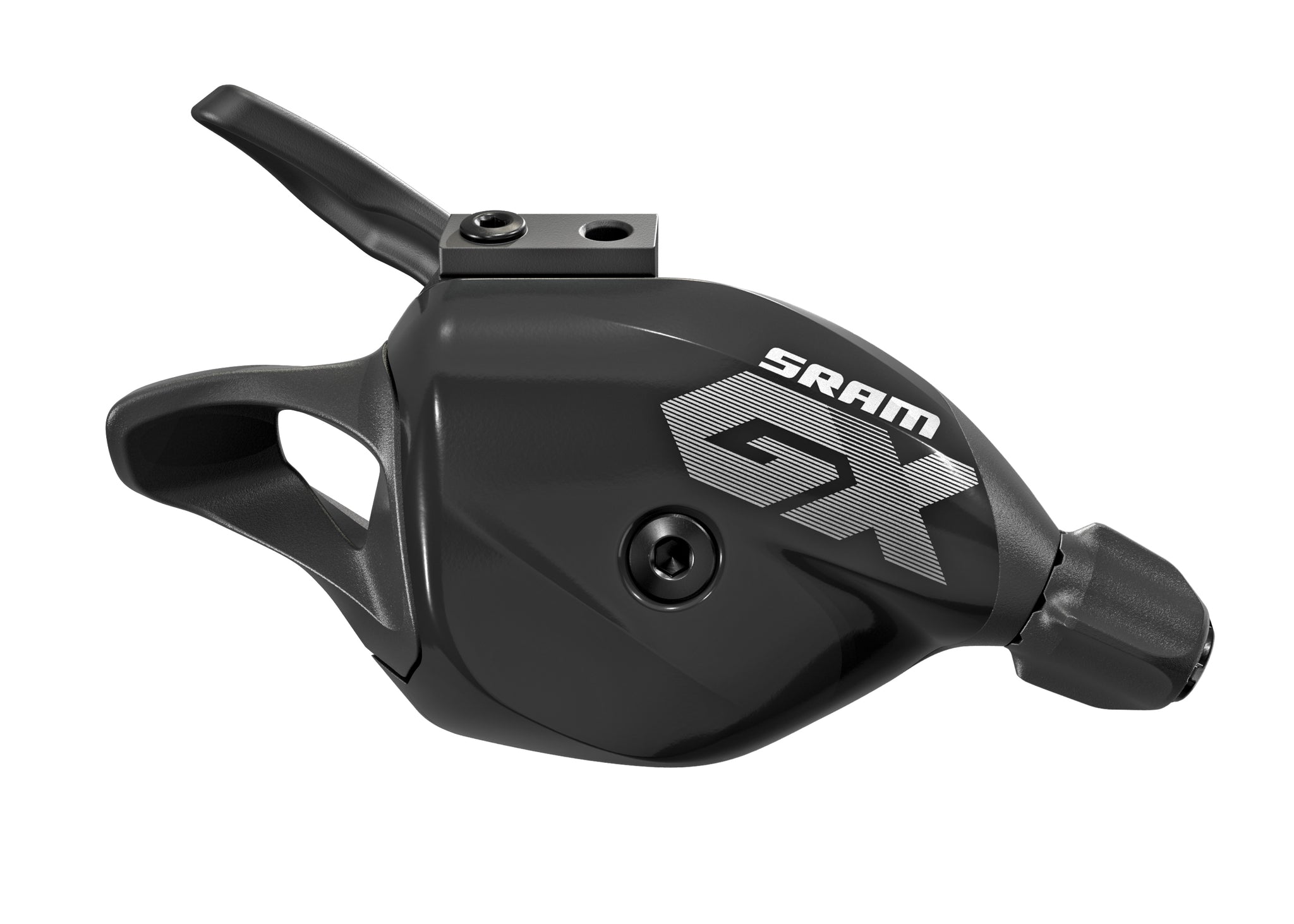 The GX and XX1 shifter internals are the same. Both have an alloy lower body but the XX1 shifter uses a carbon fiber cover, while the GX uses a plastic one.
The GX and XX1 shifter internals are the same. Both have an alloy lower body but the XX1 shifter uses a carbon fiber cover, while the GX uses a plastic one.
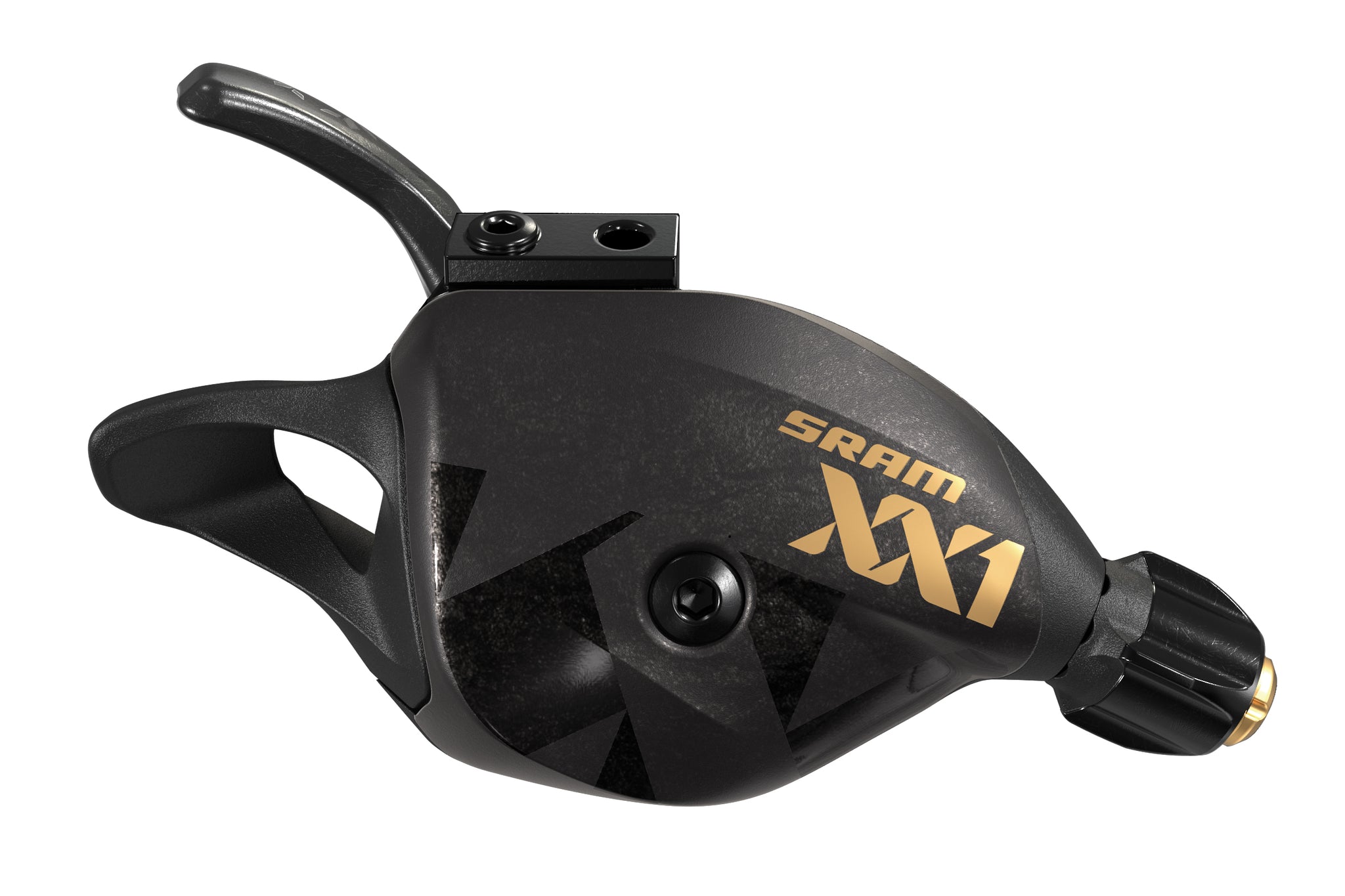 The biggest difference is ergonomics. The XX1 shifter's downshift lever can be adjusted fore and aft to suit rider preference. This is one of my favorite features because it allows me to tuck the lever farther in by a few millimeters. I run my shifter very close to the grips and this is just enough so the lever doesn’t poke my hands during rowdy descents. Notice that the XX1 thumb lever also has a slightly more sculpted shape.
The biggest difference is ergonomics. The XX1 shifter's downshift lever can be adjusted fore and aft to suit rider preference. This is one of my favorite features because it allows me to tuck the lever farther in by a few millimeters. I run my shifter very close to the grips and this is just enough so the lever doesn’t poke my hands during rowdy descents. Notice that the XX1 thumb lever also has a slightly more sculpted shape.
Some of my co-workers have commented that the XX1 shifter action feels nicer, as if the internals are more metallic, or assembled more precisely. This may or may not be a real thing, and could be due to the perception that XX1 is overall more refined.
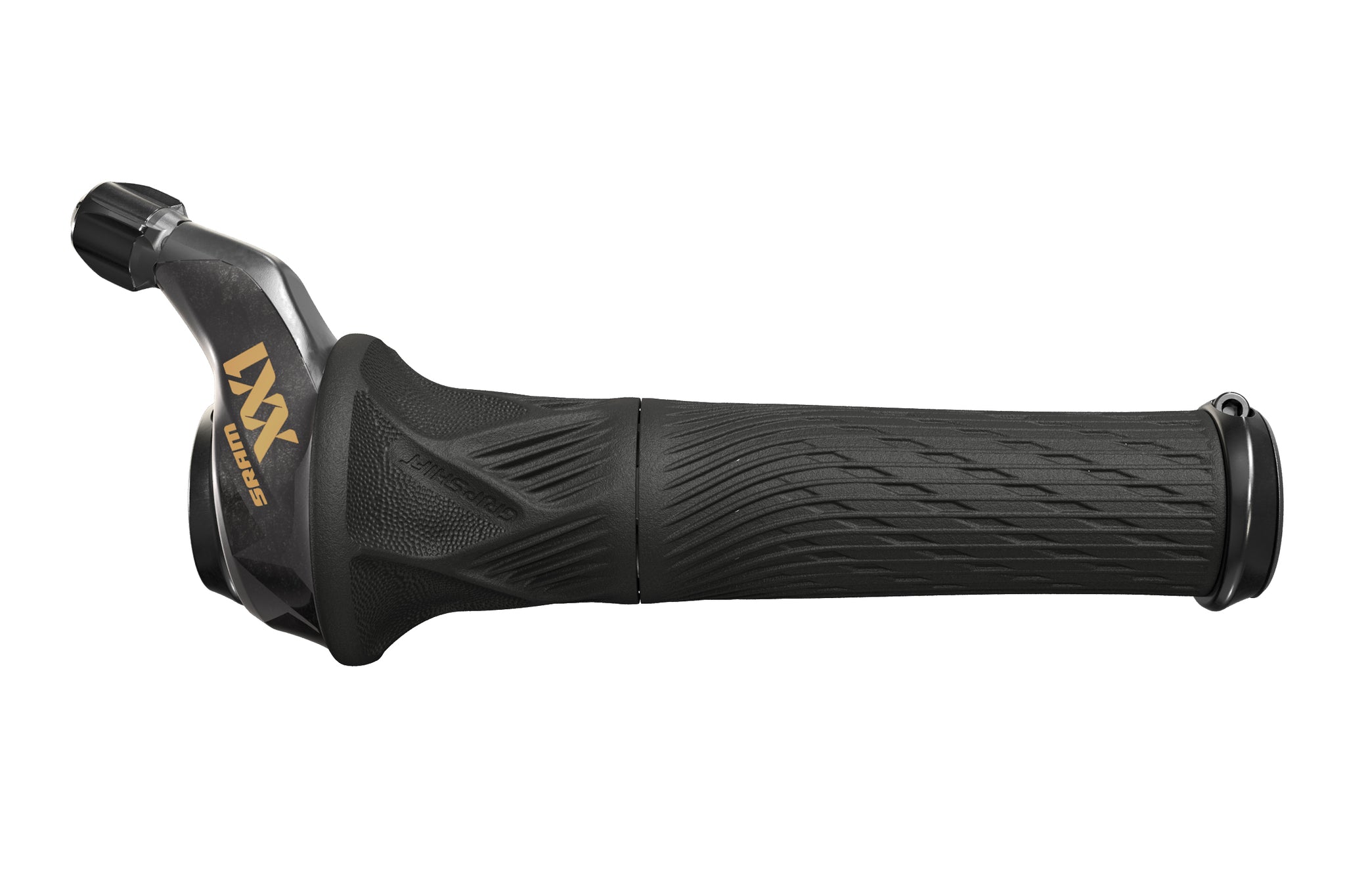 For those who like old-school twist-shifters, XX1 Eagle also has a Grip Shift option.
For those who like old-school twist-shifters, XX1 Eagle also has a Grip Shift option.
[button]Shop SRAM[/button]
Chain
 The GX chain uses solid pins while XX1 has hollow pins to reduce weight. GX uses a chrome treatment on the pins. XX1 has a gold corrosion-resistant treatment applied to the plates and pins. There is also a black color option. XX1 has much better construction, strength, and wear resistance.
The GX chain uses solid pins while XX1 has hollow pins to reduce weight. GX uses a chrome treatment on the pins. XX1 has a gold corrosion-resistant treatment applied to the plates and pins. There is also a black color option. XX1 has much better construction, strength, and wear resistance.
 I have experienced an impressive increase in chain life with XX1 Eagle chains compared to GX chains. I check my chains using Pedro's Chain Checker Plus, which I think is the most effective chain-checking tool. XX1 chains often last over twice as long (depending on use and conditions) before needing to be replaced. For me, they often outlast two chainring changes.
I have experienced an impressive increase in chain life with XX1 Eagle chains compared to GX chains. I check my chains using Pedro's Chain Checker Plus, which I think is the most effective chain-checking tool. XX1 chains often last over twice as long (depending on use and conditions) before needing to be replaced. For me, they often outlast two chainring changes.
This durability is substantiated by a test done Zero Friction Cycling, detailed in this great article by Dave Rome of CyclingTips.
GX chains are significantly cheaper than XX1 chains (about $30 vs. $80), but they require more frequent replacement. Either way, you should check your chains often and replace them sooner rather than later to reduce wear and maintain the performance of your drivetrain.
Colors
The GX Eagle drivetrain is black, with greyish-white logos. It’s nondescript and matches any bike. The XX1 Eagle drivetrain, however, is on the opposite end of the spectrum. It features an abundance of gold logos and a very blingy gold chain and cassette. This can look good, but won’t appeal to more aesthetically conservative riders. XX1 is sometimes available with blacked-out logos. There is a black XX1 chain option and the newer XX1 Eagle AXS group has given riders an oil slick color option for chains and cassettes as well.
What about X01?
X01 Eagle is the group that resides between GX and XX1 in the SRAM Eagle hierarchy. However, it isn’t a perfect middle ground between the two. In reality, it is much more similar to XX1 than it is to GX. It is significantly more expensive than GX, at around $1,275.
The X01 cranks share the same carbon construction as the XX1 cranks, but instead of being hollow, they have a foam core. This adds around 30 grams of weight but can improve durability for enduro and downhill applications.
The rear derailleur does not use a carbon fiber outer pulley cage or titanium bolts. The cassette and chain do not have the gold coating. The cassette uses a black coating, and the chain is “hard chrome.” The shifter has the adjustable thumb lever, but no carbon cover.
The weight difference between X01 and XX1 drivetrains is in the range of 30-40 grams, while the price difference is about $225. Overall, aesthetics are the biggest difference between X01 and XX1, but XX1 is just that extra bit lighter. If you don’t want the gold XX1 cassette, the X01 cassette uses the same construction but has a black coating.
[button]Shop SRAM[/button]
Final thoughts
So is it worth spending three times more on the XX1 Eagle drivetrain over GX? Unsurprisingly, the answer is: It depends.
For casual riders or those that abuse their bikes, it may not be worth it to spend more on XX1. But if you’re a competitive rider who needs the best, and wants every advantage possible, XX1 is more refined and will allow you to build the lightest bike possible.
If you don't like to stand out too much, the subtle GX is probably a better choice. But if you’re like me, and you love pomp and flash, there’s almost nothing that can match the ostentatiousness of the XX1 group.
The simple perception that XX1 is more refined can also influence your experience on the bike, and I definitely found that to be the case with the XX1's shifter action. Co-workers in the shop have commented that my XX1 equipped bikes shift better than their GX bikes. Whether that’s true is debatable. It could be due to other factors such as maintenance and tuning. Having a nicer XX1 group definitely encourages me to take better care of my drivetrain and bike.
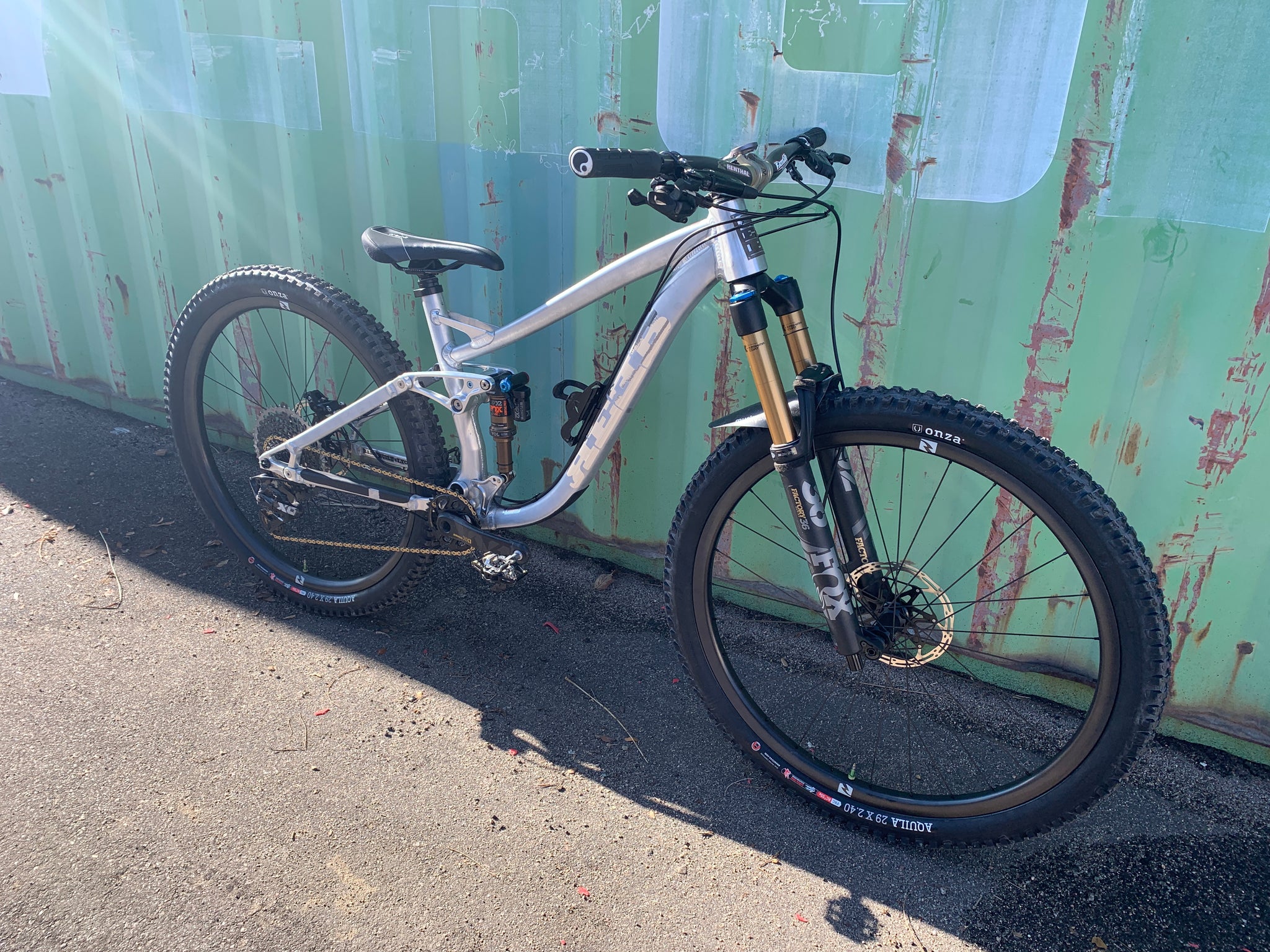 For my current bike, I’ve mixed and matched components to make a drivetrain suitable for my needs. All of SRAM's Eagle groups are essentially inter-compatible, so if you've got specific preferences, you can mix and match.
For my current bike, I’ve mixed and matched components to make a drivetrain suitable for my needs. All of SRAM's Eagle groups are essentially inter-compatible, so if you've got specific preferences, you can mix and match.
I was very concerned about weight, so I’m using XX1 cranks and an X01 cassette. The cranks and cassette are where the greatest weight savings are. I would have used the gold XX1 cassette, but it was not in stock when I built the bike. Once my current cassette wears out I’ll likely swap.
I’m using a GX derailleur and shifter (an X01 rear derailleur is pictured but I moved it to a different bike and replaced it with GX) to save some money. The shifting feels great, but I’ll likely swap to the XX1 shifter eventually because I like the adjustable thumb lever so much.
While most parts are debatable, I’d recommend the XX1 chain to any rider on an Eagle drivetrain. Gold chains (or black if you prefer) just look good. But the biggest advantage is the increased durability. I have been stunned at how long XX1 Eagle chains last. One chain lasted over 2,000 miles, through multiple chainrings, with no issues. It’s my belief that the XX1 chain is the biggest reason my Eagle drivetrains work so well. It’s also the least expensive XX1 component.
I like GX, and I think it is a great group. It’s what I use on my downhill bike park rig because that bike gets beat up and mistreated. But for my everyday trail and XC race bikes, I am at the point in my life where I’m more than willing to spend more to upgrade to the more refined and flashier XX1 group. It looks good and it makes me feel good.
Do you use SRAM Eagle on your mountain bike? What's your group of choice and why? Let us know in the comments!
All photos courtesy of SRAM.























